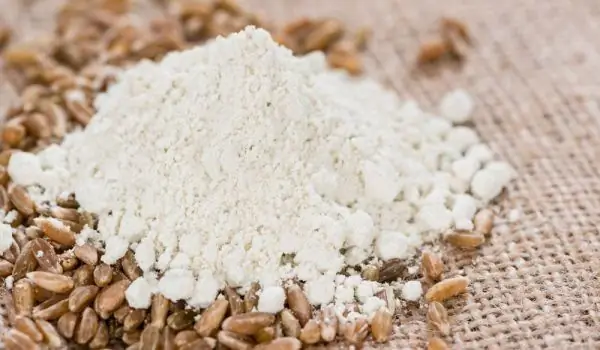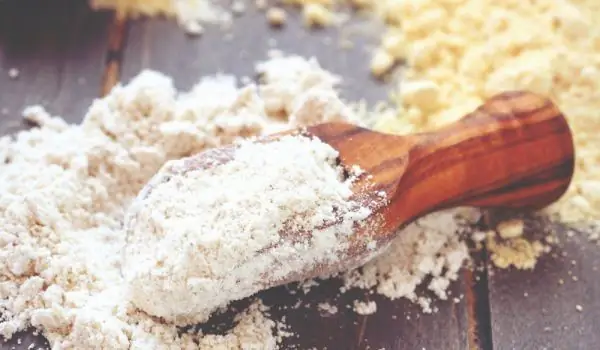2025 Author: Jasmine Walkman | [email protected]. Last modified: 2025-01-23 10:18
Rice flour is a white or yellowish powder product that is widely used in cooking. It is obtained from the seeds of rice cereals, which have long been used for food purposes. Rice grains are 5 to 12 millimeters long and 2-3 millimeters thick. They are usually white in color, but in some species the color may vary.
Rice is grown in China, Japan, India, Pakistan, Indonesia, Vietnam, Bangladesh, the Philippines, France, Spain, Italy, Greece, USA and others. In our country, rice appeared as an economic crop in the distant seventeenth century and since then has accompanied the lives of some native farmers. To date, rice plantations are not very large, but still found in the southern part of the country.
Composition of rice flour
The very fact that rice flour is produced from rice is the reason its composition is rich in minerals and vitamins. It turns out that it contains saturated, monounsaturated and polyunsaturated fats, sugars, fiber, protein and water. In addition, rice flour is rich in potassium, calcium, iron, phosphorus, magnesium, zinc, selenium, copper, manganese.
In its composition you will also find important amino acids such as alanine, arginine, valine, aspartic and glutamic acid, lysine, proline and others. Rice flour is also a source of vitamin B1, vitamin B2, vitamin B3, vitamin B4, vitamin B5, vitamin B5 and vitamin E.
Production of rice flour
Rice flour is obtained by grinding the rice grains well. The final product is a whitish powder. This valuable food product can also be produced at home in the presence of a blender or food processor. The rice is placed in the appliance and ground, and it is good to handle a small amount of grains so that they can be ground evenly. Quality rice flour is obtained mainly from milled rice. Thanks to it you will get a very fine powder, suitable for a variety of culinary uses.

Selection and storage of rice flour
If you do not have a grinder with which to grind rice at home, you can buy flour from a commercial site, and it is packaged in the same way as flour from wheat, rye, oats, millet, chickpeas and more. You will find a wide variety of the product mostly in organic food stores. When choosing a product, make sure the package is tightly closed. Also pay attention to the expiration date, as well as whether the manufacturer's name is written on the label. All this information is a guarantee of product quality.
Store rice flour in the same way as other types of flour. Keep the package in a cool and ventilated place, away from direct sunlight. Make sure you limit the access of any pests such as rodents and insects. If desired, you can store the rice flour in a glass jar, making sure it stays tightly closed throughout the storage period.
Cooking with rice flour
Rice flour is used in various recipes and can practically completely replace wheat flour. It can be used to prepare all kinds of pasta such as breads, cakes, pies, pizzas and others. It is also suitable for the production of all kinds of cakes, including Easter cakes, cupcakes, cakes and muffins. Rice flour can be used alone or mixed with another type of flour.
When cooking clean rice flour, keep in mind some culinary features of the product. This type of flour cannot be mixed with yeast. In addition, it absorbs more moisture and if you knead flour, you will need to add more eggs than wheat flour. In addition, wheat flour pastries are processed at a lower temperature and therefore baked longer. They have a crispier crust, but are lighter than other pasta.

Apart from being a component of pasta, rice flour can also be used as an ingredient in sauces and porridges. It is added to stews and soups. In Asian cuisine, it is often used in making various desserts. Due to its thickening effect, it is also used in making porridge for babies.
Benefits of rice flour
Consumption of rice flour is useful for a number of reasons. The biggest advantage of this product, however, is the lack of gluten in its composition. This directly makes rice flour pasta suitable for eating by people with gluten intolerance. We remind you that the number of people with this complaint has increased significantly in recent years.
Research also shows that rice flour acts favorably on constipation and disorder. It also has a positive effect on bloating. Rice flour is useful in diseases of the bladder and kidneys. Its intake also has a beneficial effect on hair, skin and nails.
Intake of rice flour has a tonic effect and is able to strengthen immunity during the cold winter months, when we are most susceptible to viruses. Another positive feature of rice flour is that it is dietary, which makes it a valuable participant in the menu of people struggling with excess weight.
Homemade masks with rice flour
In addition to a nutritional component with great health benefits, rice flour it is also a means of beautification. Its rich composition makes it a means of nourishing both dry and oily skin. Thanks to it, the skin is not just healthy, but smooth, soft and radiant.
To nourish [dry skin], you can prepare a mask with 3 tablespoons of rice flour, 3 drops of almond oil and 2 tablespoons of milk. The ingredients are mixed and stirred. The resulting mixture is heated slightly and applied to cleansed skin. After 30 minutes, wash off. Optionally, an additional nourishing ancient cream is applied.
If you want to prepare a mask with rice flour for oily skin, you should mix 1 tablespoon of rice powder with 4 tablespoons of lemon juice and 1/2 tablespoon of humus. The resulting substance is applied to a washed face and after 20 minutes is removed by washing.
Recommended:
Flour

Bread and water are things that human nature requires, Seneca said. As the main raw material for bread, flour is one of the most ancient products that man uses for his diet. Traditionally, bakery products are among the favorite foods of Bulgarians.
Einkorn Flour - Essence, Benefits, Application

Einkorn is a type of cereal that dates back to ancient times. Due to its more difficult processing and not so easy cultivation, however einkorn has long been one of the most common cereals. The oldest remnants of einkorn date back 18,000 years.
How To Prepare Chickpea Flour Yourself?

Chickpeas are extremely useful. It is rich in protein and works wonders for cell repair. The huge amounts of vitamin E and zinc in it improve the functions of the immune system, and the isoflavones contained in the flour protect the body from tumors.
What To Cook With Buckwheat Flour

The beneficial properties of buckwheat flour are mainly associated with its rich content of iron, calcium, potassium, phosphorus, iodine, zinc, magnesium, manganese, fiber and amino acids. Buckwheat flour is still not a commonly used product in our country, unlike in Russia.
How To Make Rice Flour

Rice flour is a very valuable product for people who suffer from diseases of the digestive system, constipation or disorder, as well as people who suffer from bloating. The lack of gluten - the protein contained in wheat - makes rice flour one of the most valuable products for preparing food for children.

